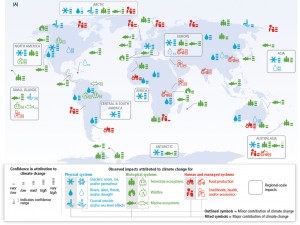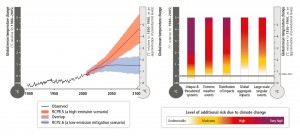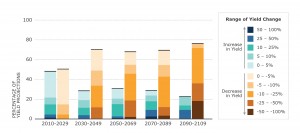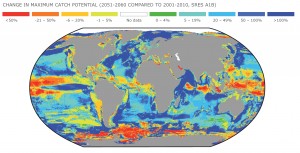Impacts of Climate Change – Part 2 of the New IPCC Report Has Been Approved
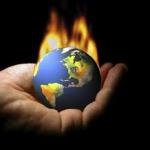
On all continents and across the oceans
Impacts of anthropogenic climatic change are observed worldwide and have been linked to observed climate using rigorous methods. Such impacts have occurred in many ecosystems on land and in the ocean, in glaciers and rivers, and they concern food production and the livelihoods of people in developing countries. Many changes occur in combination with other environmental problems (such as urbanization, air pollution, biodiversity loss), but the role of climate change for them emerges more clearly than before.
Fig. 1 Observed impacts of climate change during the period since publication of the IPCC Fourth Assessment Report 2007
During the presentation for approval of this map in Yokohama many delegates asked why there are not many more impacts on it. This is because authors only listed those cases where solid scientific analysis allowed attribution. An important implication of this is that absence of icons from the map may well be due to lacking data (such as in parts of Africa) – and certainly does not imply an absence of impacts in reality. Compared to the earlier report in 2007, a new element of these documented findings is that impacts on crop yields are now clearly identified in many regions, also in Europe. Improved irrigation and other technological advances have so far helped to avoid shrinking yields in many cases – but the increase normally expected from technological improvements is leveling off rapidly.
A future of increasing risks
More than previous IPCC reports, the new report deals with future risks. Among other things, it seeks to identify those situations where adaptation could become unfeasible and damages therefore become inevitable. A general finding is that “high” scenarios of climate change (those where global mean temperature reaches four degrees C or more above preindustrial conditions – a situation that is not at all unlikely according to part one of the report) will likely result in catastrophic impacts on most aspects of human life on the planet.
Fig. 2 Risks for various systems with high (blue) or low (red) efforts in climate change mitigation
These risks concern entire ecosystems, notably those of the Arctic and the corals of warm waters around the world (the latter being a crucial resource for fisheries in many developing countries), the global loss of biodiversity, but also the working conditions for many people in agriculture (the report offers many details from various regions). Limiting global warming to 1.5-2.0 degrees C through aggressive emission reductions would not avoid all of these damages, but the risks would be significantly lower (a similar chart has been shown in earlier reports, but the assessment of risks is now, based on the additional scientific knowledge available, more alarming than before, a point that is expressed most prominently by the deep red color in the first bar).
Food security increasingly at risk
In the short term, warming may improve agricultural yields in some cooler regions, but significant reductions are highly likely to dominate in later decades of the present century, particularly for wheat, rice and maize. The illustration is an example of the assessment of numerous studies in the scientific literature, showing that, from 2030 onwards, significant losses are to be expected. This should be seen in the context of already existing malnutrition in many regions, a growing problem also in the absence of climate change, due to growing populations, increasing economic disparities and the continuing shift of diet towards animal protein.
Fig. 3 Studies indicating increased crop yields (blue) or reduced crop yields (brown), accounting for various scenarios of climate change and technical adaptation
The situation for global fisheries is comparably bleak. While some regions, such as the North Atlantic, might allow larger catches, there is a loss of marine productivity to be expected in nearly all tropical waters, caused by warming and acidification. This affects poor countries in South-East Asia and the Pacific in particular. Many of these countries will also be affected disproportionately by the consequences of sea-level rise for coastal mega-cities.
Fig. 4 Change in maximum fish catch potential 2051-2060 compared to 2001-2010 for the climate change scenario SRES A1B
Urban areas in developing countries particularly affected
Nearly all developing countries experience significant growth in their mega-cities – but it is here that higher temperatures and limited potential for technical adaptation have the largest effect on people. Improved urban planning, focusing on the resilience of residential areas and transport systems of the poor, can deliver important contributions to adaptation. This would also have to include better preparation for the regionally rising risks from typhoons, heat waves and floods.
Conflicts in a warmer climate
It has been pointed out that no direct evidence is available to connect the occurrence of violent conflict to observed climate change. But recent research has shown that it is likely that dry and hot periods may have been contributing factors. Studies also show that the use of violence increases with high temperatures in some countries. The IPCC therefore concludes that enhanced global warming may significantly increase risks of future violent conflict.
Climate change and the economy
Studies estimate the impact of future climate change as around few percent of global income, but these numbers are considered hugely uncertain. More importantly, any economic losses will be most tangible for countries, regions and social groups already disadvantaged compared to others. It is therefore to be expected that economic impacts of climate change will push large additional numbers of people into poverty and the risk of malnutrition, due to various factors including increase in food prices.
Options for adaptation to the impacts of climate change
The report underlines that there is no globally acceptable “one-fits-all” concept for adaptation. Instead, one must seek context-specific solutions. Smart solutions can provide opportunities to enhance the quality of life and local economic development in many regions – this would then also reduce vulnerabilities to climate change. It is important that such measures account for cultural diversity and the interests of indigenous people. It also becomes increasingly clear that policies that reduce emissions of greenhouse gases (e.g., by the application of more sustainable agriculture techniques or the avoidance of deforestation) need not be in conflict with adaptation to climate change. Both can improve significantly the livelihoods of people in developing countries, as well as their resilience to climate change.
It is beyond doubt that unabated climate change will exhaust the potential for adaptation in many regions – particularly for the coastal regions in developing countries where sea-level rise and ocean acidification cause major risks.
–
The summary of the report is found here. Also the entire report with all underlying chapters is online. Further there is a nicely crafted background video.
Wolfgang Cramer is scientific director of the Institut Méditerranéen de Biodiversité et d’Ecologie marine et continentale (IMBE) in Aix-en-Provence one of the authors of the IPCC working group 2 report.

